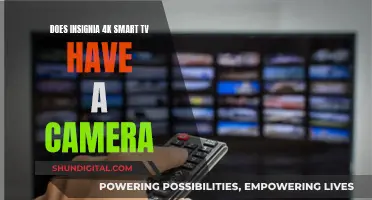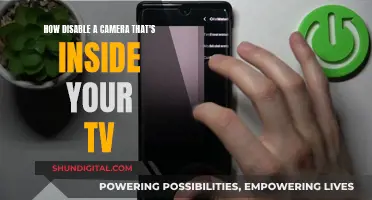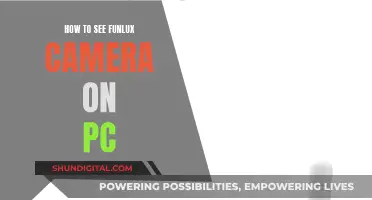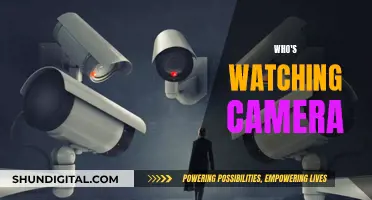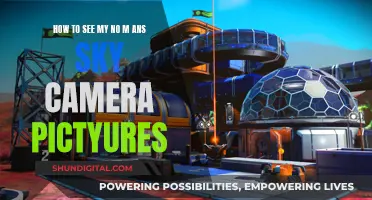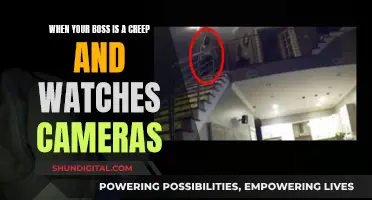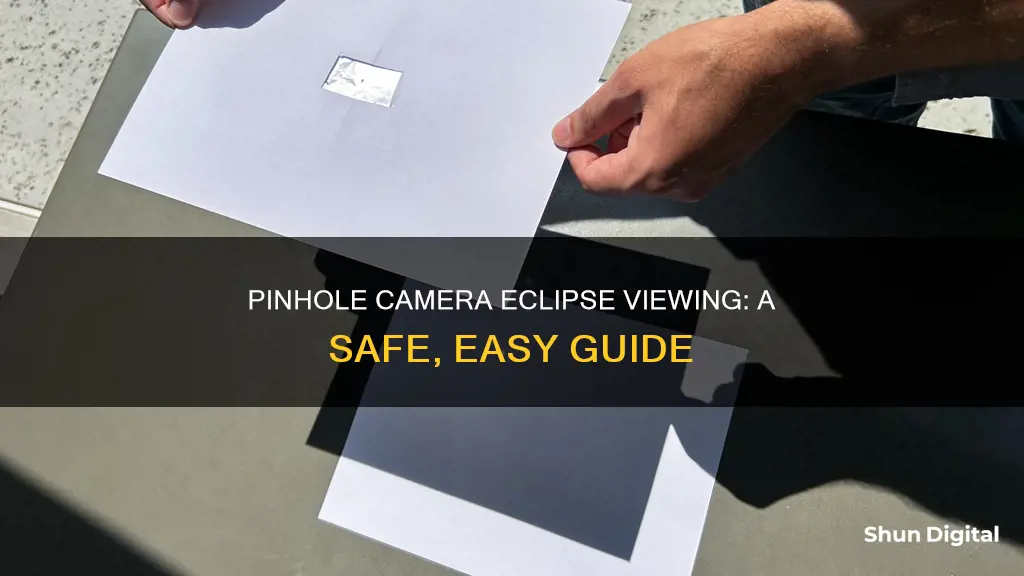
Staring at the sun is harmful to the eyes, but there are ways to watch a solar eclipse without risking your vision. One way is to build a pinhole camera out of a box, a piece of aluminium foil, and tape. The pinhole camera works by using a small hole to act as a tiny camera lens, allowing light from the sun to enter and project an image on the other side of the hole. The projected image can be viewed on a surface, such as a piece of paper or card, placed inside the box. This image can be made bigger by moving the projected surface further away from the pinhole.
| Characteristics | Values |
|---|---|
| Number of pieces of card/paper | 2 |
| Card/paper material | Stiff white cardboard or plain white paper |
| Pinhole-making tools | Thumbtack, sharp pin, needle, or paper clip |
| Pinhole size | 0.2mm wide |
| Pinhole location | Centre of the paper/card |
| Pinhole shape | Round and smooth |
| Viewing position | Back towards the sun |
| Distance between paper/card | The greater the distance, the larger the projected image |
What You'll Learn

Use two pieces of stiff white cardboard
Using two pieces of stiff white cardboard is one of the easiest ways to watch an eclipse safely. Here is a step-by-step guide on how to do it:
Firstly, gather your materials. You will need two pieces of stiff white cardboard, a thumbtack, a sharp pin, or a needle. You can also use two sheets of plain white paper, or two paper plates, as an alternative to cardboard.
Now, let's make the pinhole projector. Take one of the pieces of cardboard and make a tiny hole in the middle using a pin, thumbtack, or needle. Ensure that the hole is round and smooth.
Next, with your back towards the sun, hold one piece of cardboard above your shoulder, allowing the sun to shine on it. This will be the projector.
The second piece of cardboard will act as a screen. Hold it at a distance and you will see an inverted image of the sun projected onto the cardboard through the pinhole. To make the image of the sun larger, simply hold the screen further away from the projector.
It is important to remember to always keep your back towards the sun while looking at a pinhole projection and never look directly at the sun without protective eye gear.
Big Brother: Is the Government Spying on Us?
You may want to see also

Face away from the sun
To watch an eclipse with a pinhole camera, it is important to always face away from the sun. This is a crucial step to ensure that you do not accidentally damage your eyes from the sun's rays. Here are some detailed instructions on how to safely watch an eclipse using a pinhole camera, with a focus on facing away from the sun:
Firstly, gather your materials. You will need two pieces of stiff white cardboard, such as paper plates, or plain white paper. You will also need something sharp to make a hole, such as a thumbtack, a sharp pin, or a needle.
Now, turn your back to the sun. This is a critical step to ensure safe viewing of the eclipse. With your back to the sun, hold one piece of cardboard or paper above your shoulder, allowing the sun to shine on it. You want the sunlight to pass through the pinhole and project onto the second piece of cardboard or paper.
The second sheet of cardboard or paper will act as a screen. Hold it at a distance from the first sheet, and you will see an inverted image of the sun projected onto the paper screen through the pinhole. It is important to note that you should never look directly at the sun, even through the pinhole, as it can seriously damage your eyes.
To make the projected image of the sun larger, simply hold the screen further away from the paper with the pinhole. You can also experiment with different distances to get a sharper image. Remember to always keep your back to the sun while adjusting the distance and positioning of your projector.
By following these steps and facing away from the sun, you can safely watch an eclipse with your pinhole camera. This method ensures that you can enjoy the beauty of an eclipse without risking eye damage from direct sunlight.
Surface Cameras: Watching or Just an Urban Myth?
You may want to see also

Cut a hole in the cardboard
To watch an eclipse with a pinhole camera, you'll need to cut a hole in a piece of cardboard. This will be the first side of your pinhole camera. The hole should be relatively small, about 1 inch to 2 inches square or rectangular. You can use a pencil to draw the shape of the hole before cutting it out. It doesn't have to be perfect or even round, but make sure it's not too big, or you'll lose the pinhole camera effect.
Once you've drawn the shape, carefully cut out the hole with scissors or a sharp knife. If you're using scissors, be careful not to bend or tear the cardboard. If you're using a knife, be cautious and take your time to get a clean cut. You want to end up with a smooth edge around the hole.
Now, you'll need to cover this hole with aluminium foil. Cut a piece of foil that is slightly larger than the hole and tape it securely over the opening. Make sure the dull side of the foil is facing you. Smooth out any creases in the foil by gently rubbing it with your fingernail in a small, circular motion.
The next step is to create the pinhole in the foil. Use a pin, thumbtack, paper clip, toothpick, or embroidery needle to poke a small hole in the centre of the foil. This hole should be clean and round with smooth edges. If you're using a pin, paper clip, or pencil, be sure to use something sharp to create a neat hole. The size of the pinhole is important—it should be about 0.2 millimetres wide. If it's too big, the image you project will be blurry.
Now that you've created the pinhole, you're ready to move on to the next steps of creating your pinhole camera for eclipse viewing.
Xbox One's Camera: Watching You?
You may want to see also

Cover the hole with aluminium foil
Now it's time to cover the hole you've cut out with aluminium foil. You'll need a piece of foil that's big enough to completely cover the hole. It's important to use a smooth piece of foil, as creases can cause sunlight to be redirected. Secure the foil over the hole with tape, making sure that it's tight and no light can get into the box.
If you do find that your foil has some creases, you can smooth them out by softly rubbing the top of your fingernail over the foil in a small, circular motion.
Poke a hole in the foil
Once your foil is taped over the hole, you can use a pin, paper clip, pencil, or even an embroidery needle to poke a hole in the foil. It's important to make sure the hole is small, clean, and round—a pin is a good option as it will create a hole with non-ragged edges. If the hole is too big, you'll lose the pinhole camera effect and will just see an out-of-focus blob.
Test your pinhole camera
Now that your pinhole camera is ready, it's time to test it out! Stand with your back to the sun and look into the box through the viewport. Use your hands to block out as much light as possible and move around until you find the right angle where sunlight enters through the pinhole. When this happens, you should see a projection of the sun's shape on the white paper inside the box.
The weather will play a role in the quality of the image you see, so keep that in mind when testing out your pinhole camera.
Moto 360 Watch: Camera Feature or Missing Component?
You may want to see also

Poke a pinhole in the foil
To watch an eclipse safely, you can make a pinhole camera with two pieces of card or paper. This is a safe way to view an eclipse without looking directly at the sun, which can be extremely harmful to your eyes.
To make your pinhole camera, you will need two pieces of stiff white cardboard, or two sheets of plain white paper. You can also use card stock. You will also need something sharp to make the pinhole, such as a pin, thumbtack, needle, or paper clip.
Firstly, cut a 1-inch to 2-inch square or rectangular hole in the middle of one of the pieces of card or paper. Then, tape a piece of aluminium foil over the hole. Now, flip over your paper and use your pin to poke a small hole in the aluminium foil.
Make sure the pinhole is round and smooth. The smaller the hole, the more defined the projected image will be. You can also try poking multiple holes to make shapes and patterns. Each hole will create its own projection of the sun.
Now, with your back to the sun, hold one piece of card or paper above your shoulder so that the sun shines on it. Hold the second piece of card or paper at a distance, acting as a screen. You will see an inverted image of the sun projected onto the paper screen through the pinhole. The further away you hold the screen, the bigger the projected image will be.
Remember to never look directly at the sun without protective equipment.
Are Street Signs Watched by Cameras?
You may want to see also
Frequently asked questions
You will need a cardboard box, a piece of white paper, a pin or sharp pencil, and some tape. First, cut a small hole in the middle of one of the longer sides of the box. Then, cover the hole with a piece of aluminium foil and tape it in place. Next, poke a small hole in the centre of the foil with your pin or pencil. Finally, cover the inside of the opposite face of the box with the white paper. With your back to the sun, hold up the box and look inside – you should see a projection of the sun on the paper.
It is important to remember that you should never look directly at the sun without proper eye protection. You can seriously damage your eyes and even go blind. You should also not look at the sun through the pinhole of your camera. Instead, with your back to the sun, project the sunlight through the pinhole onto a surface and look at the image on that surface.
It is important to make sure that no light can get into your box other than through the pinhole. You can do this by sealing the box with duct tape or electrical tape. You should also make sure that the hole in the foil is smooth and round, and that the white paper is free of any wrinkles or folds, as these may distort the image.


